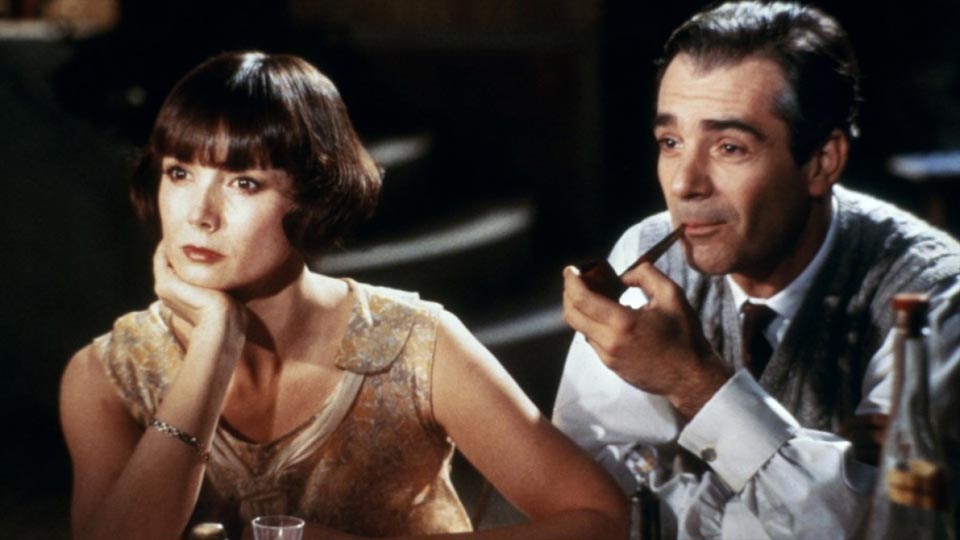Alain Resnais is a difficult figure to place within the world of the cinema. He is most certainly an auteur, an intellectual, and a humanist all at once, imbuing his films with those characteristics. Though it was early in his career when he established himself as one of France’s celebrity filmmakers with Hiroshima mon amour (1959) and Last Year In Marienbad (1961), it was in the middle of his long career when Resnais’ films began to evoke a more mature and seasoned approach to the cinema that still concerned itself with the themes that have defined him as an auteur; time, romance, and loss. The first film I saw of his that displayed both the theoretical thinker in Resnais and the emotive storyteller in equal parts was Je T’aime, je t’aime (1968). But by the time Resnais is making films in the eighties his aesthetic has become so refined, so subtle, that the nuance that once seemed impressive in Je T’aime, je t’aime and Hiroshima mon amour began to look blatant and broad in its strokes. The only way to describe this refinement that occurred at the onset of the decade is simply that Resnais had mastered a balance between the emotional and the intellectual.
Resnais’ film Life Is A Bed Of Roses (1983) is an immensely complex and playful film, weaving time, space, and narrative style simultaneously into a three prong narrative film that essentially tells the same fundamental story in three different filmic vernaculars. What is, at an intellectual level, a complicated meditation on the function of storytelling in contemporary Western Society remains, superficially, an enjoyable romantic musical comedy. But even this approach would be further refined in Love & Death (1984), eventually reaching the pinnacle of this aesthetic evolution in Melo (1986).
There had been a feverish energy to Life Is A Bed Of Roses and Love & Death that is absent in Melo. Melo, by contrast, has the feeling of painstaking preparation and detail. One may attribute this sensation to the long duration of scenes, heavy with hypnotic dialogue, or the theatricality of the framing and set design. All of which would make sense since Melo is based upon a play by Henri Bernstein. The fact that Melo, in Resnais’ hands, is transitioning from the stage to the screen accounts for the director’s approach. For as much as the film is a triumph for the actors’ performances and Bernstein’s play, it is also fundamentally concerned with the illusionary effects of the theater and of the cinema on its audience.

Consider Resnais’ use of the curtain. Each time a scene crossfades to this image the curtain is static, neither rising nor falling. Allegorically, an audience’s mind associates the movement of the curtain as either a marker of the end of an act or the beginning of one. Resnais denies this closure. For Resnais what is important is not the kind of progression signified by the curtain, but more simply that a progression in narrative time has occurred. This enables Resnais to move ahead, sometimes by years, in the film’s story without having to walk the audience through the details of what has transpired between one-act and another, relegating that duty to the context clues within the scenes themselves. This approach to narrative ellipses, prevalent in the films of Ozu and Techine, has a distinctly theatrical heritage. But unlike his peers, Resnais stresses the occurrence of the ellipse in time to his audience.
Resnais is faithful to the theatrical medium of the play not only in his approach to eliptical effects, but also in how he stages the film. When I wrote before on Life Is A Bed Of Roses some time ago I discussed the artifice of certain “fantasy” segments. In Melo these moments of a fantasy world do not exist, they are the constant norm. The Brechtian notion that theater engages reality by imitating it is at the heart of this device. However, its manifestation in the cinema of Resnais is far from the minimalist exercises of Malle’s Vanya On 42nd Street (1994) or Rainer Werner Fassbinder’s The Niklashausen Journey (1971). Resnais prefers the lush sets of warm color and hand-painted night skies of Powell & Pressburger’s Tales Of Hoffmann (1952) and The Red Shoes (1948). This cuts any physical connection out of the film between the reality of the audience and the reality of Melo. Resnais takes this one step further by manipulating light not in the traditional sense of narrative film as in, say, Bertolucci’s The Conformist (1970). On the contrary, Resnais embraces the theatricality of spotlights and fades, as if he is aware that to a film audience these technical devices are as likely to evoke images of the stage as they are to emote the dreamy whimsy of Arthur Freed’s MGM musicals of the forties and fifties.
All of this theatricality and the self-awareness its manipulations are indicative of would mean little other than a formalist exercise if it wasn’t for what Resnais does with it. Like Last Year In Marienbad, Melo is an achievement in blocking and choreography. The performers have been staged so that every effect and set piece is instrumental in its contribution not only to the actors’ performance, but the emotional potency of every image. The meticulousness of the arrangements in Melo rival even some of F.W. Murnau’s greatest dramas for their heartbreaking fragility and overwhelming sincerity. When the artifice of a theatrical world like that in Melo is put to the service of the drama, as opposed to spectacle, the drama of the narrative surpasses reality in its ability to effect an audience. This is not Jean-Marie Straub’s cinema of the intellect, this is pure emotional filmmaking on par with John Cassavetes, though in an entirely removed cinematic style.
